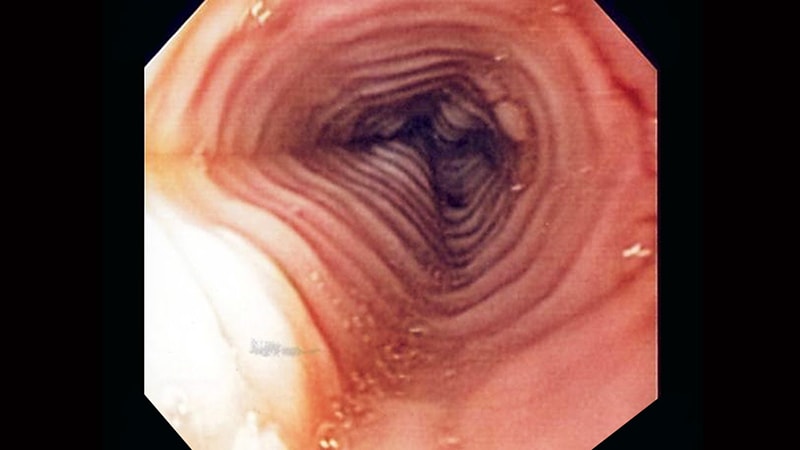Comprehensive French Guidelines on Diagnosing and Managing Eosinophilic Esophagitis in Adults
Główne pojęcia
Eosinophilic esophagitis is a chronic, allergic condition characterized by eosinophilic inflammation of the esophagus, requiring systematic biopsies for diagnosis and a multifaceted treatment approach to achieve symptomatic relief, histological remission, and prevent relapses.
Streszczenie
The content outlines the first French recommendations on eosinophilic esophagitis in adults, developed under the auspices of the French National Society of Gastroenterology. Key highlights include:
- Eosinophilic esophagitis is a relatively new and emerging chronic esophageal condition of allergic and immunologic origin, with an estimated incidence of 50 per 100,000 people.
- It is the leading cause of dysphagia in young adults and can also lead to food impactions.
- Diagnosis requires a count of at least 15 eosinophils per high-power field in esophageal biopsies, along with systematic biopsies during endoscopy regardless of mucosal appearance.
- Treatment aims to achieve symptomatic relief, histological remission (less than 15 eosinophils/high-power field), and prevent relapses.
- First-line treatments include proton pump inhibitors (50%-60% effective), followed by topical corticosteroids (85% effective) and the elimination diet if previous treatments fail.
- Endoscopic dilation can improve symptoms in the fibro-stenotic form, but systemic corticosteroids are not recommended.
- Maintenance treatment is necessary, as 90% of patients relapse upon discontinuation of effective therapies.
- Early diagnosis and treatment can prevent long-term fibro-stenotic complications.
Customize Summary
Rewrite with AI
Generate Citations
Translate Source
To Another Language
Generate MindMap
from source content
Visit Source
www.medscape.com
First French Recommendations on Eosinophilic Esophagitis
Statystyki
Eosinophilic esophagitis has an estimated incidence of 50 per 100,000 people.
70%-80% of adults with eosinophilic esophagitis experience dysphagia with solid foods.
33%-54% of adults with eosinophilic esophagitis experience food impaction.
Approximately 17% of adults with eosinophilic esophagitis have a normal endoscopic appearance of the esophagus.
Proton pump inhibitors are 50%-60% effective in inducing clinical and histological response.
Orodispersible budesonide is 85% effective in inducing clinical and histological response at 12 weeks.
Dupilumab, a monoclonal antibody, has an efficacy of approximately 80% at 24 weeks.
Cytaty
"Early diagnosis and treatment of eosinophilic esophagitis can prevent long-term fibro-stenotic complications."
"There is a strong recommendation, backed by moderate evidence, for the performance of at least six esophageal biopsies taken from at least two sites of the esophagus for diagnosis and follow-up."
"Eosinophilic infiltration is uneven, hence the need for multiple biopsies along the esophagus."
Kluczowe wnioski z
by Nathalie Raf... o www.medscape.com 04-12-2024
https://www.medscape.com/viewarticle/first-french-recommendations-eosinophilic-esophagitis-2024a10006zn
Głębsze pytania
What are the potential long-term complications of untreated eosinophilic esophagitis, and how can early intervention mitigate these risks?
Untreated eosinophilic esophagitis can lead to long-term complications such as fibro-stenotic evolution, which can result in strictures in the esophagus. This can cause dysphagia with solid foods and potential food impactions, leading to significant discomfort and complications. Early intervention is crucial in mitigating these risks by initiating treatment to achieve symptomatic relief, histological remission, and preventing relapses. By diagnosing and treating eosinophilic esophagitis early, the progression to fibro-stenotic complications can be prevented, improving the overall prognosis for patients.
How do the treatment recommendations for eosinophilic esophagitis in adults differ from those for children, and what are the unique considerations for each population?
Treatment recommendations for eosinophilic esophagitis in adults may differ from those in children due to factors such as the patient's age, weight, comorbidities, and response to specific therapies. In adults, the first-line treatment often includes proton pump inhibitors (PPIs), orodispersible budesonide, or an elimination diet. On the other hand, children may require different dosages or formulations of medications based on their age and weight. Additionally, the implementation of an elimination diet in children may require close supervision by a pediatric dietitian to ensure proper nutrition and growth. Unique considerations for children also include the impact of treatment on growth and development, as well as the need for ongoing monitoring and adjustments to the treatment plan as they grow.
What role do emerging therapies, such as biologics targeting specific cytokines, play in the future management of refractory or severe cases of eosinophilic esophagitis?
Emerging therapies, such as biologics targeting specific cytokines like dupilumab, play a significant role in the future management of refractory or severe cases of eosinophilic esophagitis. These biologics offer targeted treatment options that can modulate the immune response involved in the pathogenesis of the condition. In cases where traditional treatments like PPIs or corticosteroids have failed to induce remission, biologics provide an alternative approach to managing eosinophilic esophagitis. By specifically targeting interleukin receptors involved in the inflammatory process, biologics offer a more tailored and effective treatment option for patients with severe or refractory disease.
0
